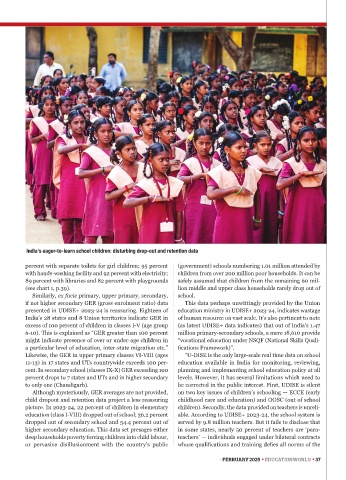Page 37 - EW February 2025_Neat
P. 37
India's eager-to-learn school children: disturbing drop-out and retention data
percent with separate toilets for girl children; 95 percent (government) schools numbering 1.01 million attended by
with hands-washing facility and 92 percent with electricity; children from over 200 million poor households. It can be
89 percent with libraries and 82 percent with playgrounds safely assumed that children from the remaining 60 mil-
(see chart 1, p.39). lion middle and upper class households rarely drop out of
Similarly, ex facie primary, upper primary, secondary, school.
if not higher secondary GER (gross enrolment ratio) data This data perhaps unwittingly provided by the Union
presented in UDISE+ 2023-24 is reassuring. Eighteen of education ministry in UDISE+ 2023-24, indicates wastage
India’s 28 states and 8 Union territories indicate GER in of human resource on vast scale. It’s also pertinent to note
excess of 100 percent of children in classes I-V (age group (as latest UDISE+ data indicates) that out of India’s 1.47
6-10). This is explained as “GER greater than 100 percent million primary-secondary schools, a mere 18,610 provide
might indicate presence of over or under-age children in “vocational education under NSQF (National Skills Quali-
a particular level of education, inter-state migration etc.” fications Framework)”.
Likewise, the GER in upper primary classes VI-VIII (ages “U-DISE is the only large-scale real time data on school
11-13) in 17 states and UTs countrywide exceeds 100 per- education available in India for monitoring, reviewing,
cent. In secondary school (classes IX-X) GER exceeding 100 planning and implementing school education policy at all
percent drops to 7 states and UTs and in higher secondary levels. However, it has several limitations which need to
to only one (Chandigarh). be corrected in the public interest. First, UDISE is silent
Although mysteriously, GER averages are not provided, on two key issues of children’s schooling — ECCE (early
child dropout and retention data project a less reassuring childhood care and education) and OOSC (out of school
picture. In 2023-24, 22 percent of children in elementary children). Secondly, the data provided on teachers is unreli-
education (class I-VIII) dropped out of school; 36.2 percent able. According to UDISE+ 2023-24, the school system is
dropped out of secondary school and 54.4 percent out of served by 9.8 million teachers. But it fails to disclose that
higher secondary education. This data set presages either in some states, nearly 50 percent of teachers are ‘para-
deep households poverty forcing children into child labour, teachers’ — individuals engaged under bilateral contracts
or pervasive disillusionment with the country’s public whose qualifications and training defies all norms of the
FEBRUARY 2025 EDUCATIONWORLD 37

